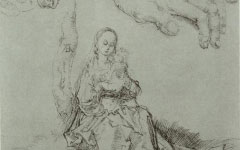Dürer’s Angel with the Sudarium (1516)
St. Veronica’s veil was the cloth with which she wiped Christ’s face after his death and on which the imprint of his face was left. In Dürer's etching (below) the cloth with its miraculous image is held by the angel as though it is being blown by the wind. That is the narrative reading. A more compelling interpretation, from the point-of-view of the artist, is that the angel is a spiritual alter ego hanging the print up to dry in the studio. All etchings come out wet from the press. It is a gesture that any printmaker would be familiar with, easily recognized by an artist.
The print the angel holds is the image of Christ who, as the divine artist, is Durer's alter ego as well. We know that because, on another occasion, Dürer drew his self-portrait in watercolor on a piece of linen, as though he were Christ, and gave it to Raphael.1 It has sadly been lost. Thus, as in so many other examples on EPPH, the two principal elements in the composition, the angel and the cloth, represent the artist and his art.
The use of an artist’s pose in another context is a common strategy in art and one that you should always be alert for. Take a look at a very similar etching of a completely different subject four hundred years later: John Sloan's Hanging Clothes (c.1920).
More Works by Dürer
Notes:
1. Zbynek Smetana, Titian’s Mirror: Self-Portrait and Self-Image in the Late Works, PhD. Diss. (Rutgers University, NJ) 1997, pp. 50-51
Original Publication Date on EPPH: 20 Apr 2010. | Updated: 0. © Simon Abrahams. Articles on this site are the copyright of Simon Abrahams. To use copyrighted material in print or other media for purposes beyond 'fair use', you must obtain permission from the copyright owner. Websites may link to this page without permission (please do) but may not reproduce the material on their own site without crediting Simon Abrahams and EPPH.




